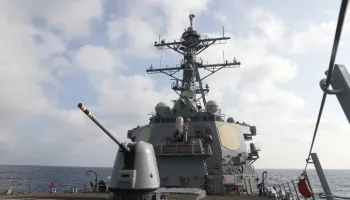A day after China said it drove a U.S. Navy destroyer away from Beijing claimed Waters in the South China Sea, the U.S. 7th Fleet said, the same warship sailed through those Waters to challenge the Chinese claims.

Thank you for the guided missile destroyer USS Milius asserting navigational rights and freedoms in the South China Sea. On the Parasol Islands, consistent with international law, the warship conducted what the U.S. Navy calls a freedom of navigation operation, or fonop bakik, challenging the restrictions on innocent passage imposed by the people of the Republic of China, Taiwan, and Vietnam.
All three claim the parasols known as the zicas in China, a group of about 130 small adults, the biggest of which are home to Chinese military bases. The U.S. statement also said the milliest challenge China’s claim to straight baselines in closing.
The paracels, meaning Beijing claims the waters between the islands even when those waters are outside the internationally recognised 12 nautical mile limit from a coastline for territorial waters. China claims almost all of the vast South China Sea as part of its territorial waters, including many distant islands and lands in the disputed body of water, many of which Beijing has militarised.
Other claimants besides Taiwan and Vietnam include Brunei and Malaysia. Indonesia and the Philippines, which have seen an unjudicial ruling in their favour in a dispute with Beijing over islands in the Spratly group, have rejected the unruling and built up military bases on those disputed islands in the Spratlys, known in China as the Nancha Islands, as they did in the Parasols on Friday.
China reacted angrily to the presence of the U.S. warship near the islands. It claims the actions of the U.S. military have seriously violated China’s sovereignty and security and violated international law. Tan Kepe, a spokesperson for the defence ministry, said in a statement that the guided missile destroyer USS Milius broke into China’s Xinjiang territorial waters again without the approval of the Chinese government, undermining peace and stability in the South China Sea.
Tansaidon Thursday, Beijing said the Milius was driven away from the paracels by the people’s Liberation Army forces, a claim that was called false by the U.S. 7th Fleet. Beijing has made similar claims after other FONOPs, which the U.S. conducts regularly around the Paracels and the Spratlys to the south of foreign Vietnam and south of China.
Hainan Island Beijing regularly makes statements that any U.S. Navy operations in the South China Sea will increase tensions and show that Washington and its partners who keep a naval presence in the Waterway are damaging the region’s security.
The area around the paracels was the site of a tense encounter between a Chinese warplane and U.S. reconnaissance jet in February that was witnessed by a CNN crew then, and now Washington is consistent in its statements about its South China Sea operations.
The operations demonstrate that the United States will fly, sail, and operate wherever international law allows regardless of the location of excessive maritime claims and regardless of current events. Friday’s statement, like many others before it, said that in recent years, the South China Sea has emerged as a major potential flash point in the Asia Pacific.
Not only does the Strategic Waterway hold vast resources of fish oil and gas, but about a third of global shipping passes through it, worth about 3.4 trillion dollars in 2016, according to the Centre for Strategic and International Studies.
China’s power project China also conducts regular military exercises in the South China Sea and maintains a large presence of Coast Guard and fishing vessels in the disputed waters, which has frequently stoked tensions with other claimants.










